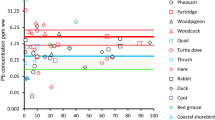Abstract
Lead exposure in New Jersey raptors was assessed by analyzing liver samples from carcasses obtained from wildlife rehabilitators. Samples were collected from 221 individuals representing 13 species. Concentrations were within the range of normal background exposure in 12 species. One red-tailed hawk had a liver lead concentration consistent with clinical poisoning (7.4 μg/g wet weight), which represents an incidence of 1% (1/104) in that species and 0.5% (1/221) in the overall sample. A second red-tailed hawk had a liver lead concentration consistent with subclinical exposure (2.1 μg/g wet weight). The combined incidence of elevated exposure (subclinical exposure + clinical poisoning) was 2% (2/104) in red-tailed hawks and 1% (2/221) in the overall sample.
Similar content being viewed by others
References
Bellrose FC (1959) Lead poisoning as a mortality factor in waterfowl populations. Ill Nat Hist Surv Bull 27:235–288
Cade TJ (2007) Exposure of California condors to lead from spent ammunition. J Wildl Manage 71:2125–2133
Clark AJ, Scheuhammer AM (2003) Lead poisoning in upland-foraging birds of prey in Canada. Ecotoxicol 12:23–30
Deem SL, Terrell SP, Forrester DJ (1998) A retrospective study of morbidity and mortality of raptors in Florida: 1988–1994. J Zoo Wildl Med 29:160–164
Eisler R (1988) Lead hazards to fish, wildlife, and invertebrates: a synoptic review, contaminant hazard reviews, report number 14, US fish and wildlife service. Patuxent Wildlife Research Center, Laurel, MD
Fisher IJ, Pain DJ, Thomas VG (2006) A review of lead poisoning from ammunition sources in terrestrial birds. Biol Conserv 131:421–432
Fix AS, Barrows SZ (1990) Raptors rehabilitated in Iowa during 1996 and 1997: a retrospective study. J Wildl Dis 26:18–21
Franson JC (1996) Interpretation of tissue lead residues in birds other than waterfowl. In: Beyer WN, Heinz GH, Redmon-Norwood AW (eds) Environmental contaminants in wildlife: interpreting tissue concentrations. CRC Press, Lewis Publishers, New York, p 265
Henny CJ, Blus LJ, Hoffman DJ, Grove RA (1994) Lead in hawks, falcons and owls downstream from a mining site on the Coeur D’Alene River, Idaho. Environ Monit Assess 29:267–288
Hunt WG, Parish CN, Orr K, Aguilar RF (2009) Lead poisoning and the reintroduction of the California condor in northern Arizona. J Avian Med Surg 23:145–150
Johnsgard PA (1990) Hawks, eagles and falcons of North America. Smithsonian Institution Press, Washington, DC
Kendall RJ, Lacher E Jr, Bunck C, Daniel B, Driver C, Grue CE, Leighton F, Stansley W, Watanabe PG, Whitworth M (1996) An ecological risk assessment of lead shot exposure in non-waterfowl avian species: upland game birds and raptors. Environ Toxicol Chem 15:4–20
Martin PA, Campbell D, Hughes K, McDaniel T (2008) Lead in tissues of terrestrial raptors in southern Ontario, Canada, 1995–2001. Sci Tot Environ 391:96–103
Mateo R, Estrada J, Paquet J-Y, Riera X, Domínguez L, Guitart R, Martínez-Vilalta A (1999) Lead shot ingestion by marsh harriers Circus aeruginosus from the Ebro Delta, Spain. Environ Pollut 104:435–440
Morishita TY, Fullerton AT, Lowenstine LJ, Gardner IA, Brooks DL (1998) Morbidity and mortality in free-living raptorial birds of northern California: a retrospective study, 1983–1994. J Avian Med Surg 12:78–81
NJDFW (2005) Fish and wildlife digest, hunting issue. New Jersey Division of Fish and Wildlife, Trenton, NJ
NJDFW (2010) Fish and wildlife digest, hunting issue. New Jersey Division of Fish and Wildlife, Trenton, NJ
Pain DJ, Bavoux C, Burneleau G (1997) Seasonal blood lead concentrations in marsh harriers Circus aeruginosus from Chatrente-Maritime, France: relationship with the hunting season. Biol Conserv 81:1–7
Rattner BA, Franson JC, Sheffield SR, Goddard CI, Leonard NJ, Stang D, Wingate PJ (2008) Sources and implications of lead ammunition and fishing tackle on natural resources, wildlife society technical review 08–01. The Wildlife Society, Bethesda, MD
USFWS (1976) Proposed use of steel shot for hunting waterfowl in the United States, final environmental statement. Department of the Interior, US Fish and Wildlife Service, Washington, DC
Wendell MD, Sleeman JM, Kratz G (2002) Retrospective study of morbidity and mortality of raptors admitted to Colorado state university veterinary teaching hospital during 1995 to 1998. J Wildl Dis 38:101–106
Author information
Authors and Affiliations
Corresponding author
Rights and permissions
About this article
Cite this article
Stansley, W., Murphy, L.A. Liver Lead Concentrations in Raptors in New Jersey, USA, 2008—2010. Bull Environ Contam Toxicol 87, 171–174 (2011). https://doi.org/10.1007/s00128-011-0327-7
Received:
Accepted:
Published:
Issue Date:
DOI: https://doi.org/10.1007/s00128-011-0327-7




